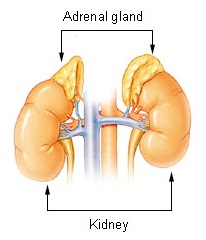Related Research Articles

The adrenal glands are endocrine glands that produce a variety of hormones including adrenaline and the steroids aldosterone and cortisol. They are found above the kidneys. Each gland has an outer cortex which produces steroid hormones and an inner medulla. The adrenal cortex itself is divided into three main zones: the zona glomerulosa, the zona fasciculata and the zona reticularis.

The sympathetic nervous system (SNS) is one of the three divisions of the autonomic nervous system, the others being the parasympathetic nervous system and the enteric nervous system.

The renin–angiotensin system (RAS), or renin–angiotensin–aldosterone system (RAAS), is a hormone system that regulates blood pressure and fluid and electrolyte balance, as well as systemic vascular resistance.
Diuresis is increased urination and the physiologic process that produces such an increase. It involves extra urine production in the kidneys as part of the body's homeostatic maintenance of fluid balance.

Cortisol is a steroid hormone, in the glucocorticoid class of hormones. When used as a medication, it is known as hydrocortisone.

The microcirculation is the circulation of the blood in the smallest blood vessels, the microvessels of the microvasculature present within organ tissues. The microvessels include terminal arterioles, metarterioles, capillaries, and venules. Arterioles carry oxygenated blood to the capillaries, and blood flows out of the capillaries through venules into veins.

The juxtaglomerular apparatus is a structure in the kidney that regulates the function of each nephron, the functional units of the kidney. The juxtaglomerular apparatus is named because it is next to (juxta-) the glomerulus.
Hypovolemia, also known as volume depletion or volume contraction, is a state of abnormally low extracellular fluid in the body. This may be due to either a loss of both salt and water or a decrease in blood volume. Hypovolemia refers to the loss of extracellular fluid and should not be confused with dehydration.

Acute-phase proteins (APPs) are a class of proteins whose plasma concentrations increase or decrease in response to inflammation. This response is called the acute-phase reaction. The acute-phase reaction characteristically involves fever, acceleration of peripheral leukocytes, circulating neutrophils and their precursors. The terms acute-phase protein and acute-phase reactant (APR) are often used synonymously, although some APRs are polypeptides rather than proteins.
Leukocytosis is a condition in which the white cell is above the normal range in the blood. It is frequently a sign of an inflammatory response, most commonly the result of infection, but may also occur following certain parasitic infections or bone tumors as well as leukemia. It may also occur after strenuous exercise, convulsions such as epilepsy, emotional stress, pregnancy and labor, anesthesia, as a side effect of medication, and epinephrine administration. There are five principal types of leukocytosis:
- Neutrophilia
- Lymphocytosis
- Monocytosis
- Eosinophilia
- Basophilia

Hyperplasia, or hypergenesis, is an increase in the amount of organic tissue that results from cell proliferation. It may lead to the gross enlargement of an organ, and the term is sometimes confused with benign neoplasia or benign tumor.

Respiratory alkalosis is a medical condition in which increased respiration elevates the blood pH beyond the normal range (7.35–7.45) with a concurrent reduction in arterial levels of carbon dioxide. This condition is one of the four basic categories of disruption of acid–base homeostasis.

Hypoaldosteronism is an endocrinological disorder characterized by decreased levels of the hormone aldosterone. Similarly, isolated hypoaldosteronism is the condition of having lowered aldosterone without corresponding changes in cortisol.
Cardiorespiratory fitness (CRF) refers to the ability of the circulatory and respiratory systems to supply oxygen to skeletal muscles during sustained physical activity. The primary measure of CRF is VO2 max. In 2016, the American Heart Association published an official scientific statement advocating that CRF be categorized as a clinical vital sign and should be routinely assessed as part of clinical practice.
Central venous pressure (CVP) is the blood pressure in the venae cavae, near the right atrium of the heart. CVP reflects the amount of blood returning to the heart and the ability of the heart to pump the blood back into the arterial system. CVP is often a good approximation of right atrial pressure (RAP), although the two terms are not identical, as a pressure differential can sometimes exist between the venae cavae and the right atrium. CVP and RAP can differ when arterial tone is altered. This can be graphically depicted as changes in the slope of the venous return plotted against right atrial pressure.
Effective renal plasma flow (eRPF) is a measure used in renal physiology to calculate renal plasma flow (RPF) and hence estimate renal function. The eRPF can be calculated with
Medullipin is a hormone created by the interstitial cells of renal papilla, which is converted to medullipin II in the liver. This, in turn, results in vasodilation and decreased blood pressure.

Aminohippuric acid or para-aminohippuric acid (PAH), a derivative of hippuric acid, is a diagnostic agent useful in medical tests involving the kidney used in the measurement of renal plasma flow. It is an amide derivative of the amino acid glycine and para-aminobenzoic acid that is not naturally found in humans; it needs to be IV infused before diagnostic use.
Cardiovascular drift is the phenomenon where some cardiovascular responses begin a time dependent change, or "drift" after around 5-10 minutes of exercise in a warm or neutral environment without an increase in workload. It is characterised by decreases in mean arterial pressure and stroke volume and a parallel increase in heart rate. It has been shown that a reduction in stroke volume due to dehydration is almost always due to the increase in internal temperature. It is influenced by many factors, most notably the ambient temperature, internal temperature, hydration and the amount of muscle tissue activated during exercise. To promote cooling, blood flow to the skin is increased, resulting in a shift in fluids from blood plasma to the skin tissue. This results in a decrease in pulmonary arterial pressure and reduced stroke volume in the heart. To maintain cardiac output at reduced pressure, the heart rate must be increased.
In physiology, splay is the difference between urine threshold and saturation, or TM, where saturation is the exhausted supply of renal reabsorption carriers. In simpler terms, splay is the concentration difference between a substance's maximum renal reabsorption vs. appearance in the urine. Splay is usually used in reference to glucose; other substances, such as phosphate, have virtually no splay at all. Splay appears to occur because kidney nephrons do not have the same tubular maximum for glucose (TmG) therefore some nephrons may excrete before others and also because "the maximum reabsorption rate cannot be achieved until the amount/min of glucose being presented to the renal tubules is great enough to fully saturate the receptor sites". John Field of the American Physiological Society said "Since the splay may occur when the residual nephrons are said to be free of anatomic abnormalities, the possibility exists that changes in the kinetics of glucose reabsorption may have been induced".
References
- 1 2 Rennke, Helmut G.; Denker, Bradley M. (2007). Renal Pathophysiology: The Essentials . Lippincott Williams & Wilkins. p. 46. ISBN 9780781796262 . Retrieved 1 November 2018.
Effective circulating volume.
- ↑ Marik, Paul Ellis (2001). Handbook of Evidence-Based Critical Care. Springer Science & Business Media. p. 110. ISBN 9780387951539 . Retrieved 1 November 2018.